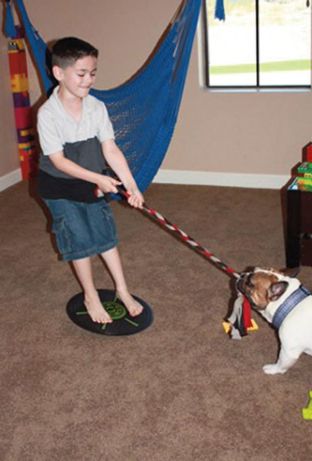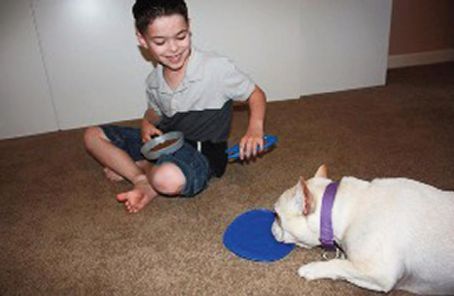I soon stopped attending his OT sessions, but one day while still taking my son to OT, as I waited in the lobby, I could hear children yelling in non-compliance inside other rooms. My immediate thought: they need a dog back there. Then it clicked. Why couldn’t they have a dog back there? It works for us at home. I began researching Therapy dogs, what they are, what they do, how to become one, and started formal Animal Therapy training with Zoe. Then I began researching non-profit 501(c)3 organizations, including the many intricacies involved in setting one up. In early 2014, Zoe became an official Animal Therapy dog through a nationally accredited organization. By the end of 2014, Pawsitive Friendships had not only been formed, we received our official 501(c)3 status. We were ready to make a Pawsitive impact!


LEARNING THE ROPES: (Left) Early successes prompted me to incorporate Zoe into every exercise and activity he did. I then added my other Frenchie Jacques, who was still a puppy, into the mix; (Above) Jacques not only helped my son build up his upper body strength, he helped with his life skills, as well.
Zoe and I visited countless clinics, describing Pawsitive Friendships’ structure, purpose and goals. Despite many disappointing rejections, in early 2015 we had a breakthrough with a single clinic. The administration allowed us to work with two clients and their therapists. The results of our sessions duplicated the results of the sessions with my son! I immediately began recruiting additional teams of registered Animal Therapy dogs and volunteer handlers, and by the end of the year, we had seven teams working at this particular clinic as well as at a private Autism school.
Looking back, I'm still amazed that what was originally an in-home project with my son and two dogs, is now "pawsitively" impacting thousands of special needs community members across Arizona. Whenever I see our logo, comprised of my son and Jacques, I'm reminded of the struggles we worked through and the successes we achieved.
Working in a school differed from working in a clinic. There was no therapist facilitating the activities. Instead the teachers and para-professionals were focused on the students, and Pawsitive Friendships was supplying the activities. After that first school year, I drew up a list of ideas and put them into practice with my son. My next step was having speech and occupational therapists review our lessons and add the formal terminology to our activities. Pawsitive Friendships now uses a structured and copyrighted curriculum for all of our programs.
We started receiving requests for hypoallergenic dogs. Shortly after, I brought home a four-week-old potbelly pig named Penelope,
who provided an entirely new level of learning and self-regulation to my son’s progress. Because she was so young, she squealed incessantly and was extremely skittish. My son had to learn that if he didn’t want her to squeal and run away, he would have to be calm in both his body language and voice. For her part, Penelope accepted my son’s meltdowns and loud, sudden movements as “normal.” Being someone who thrives on thinking “outside the box,” I considered Penelope a potential substitute for a hypoallergenic dog and began training her in earnest! When she turned one, she started working as a Therapy pig, adding another dimension of sensory integration to our existing programs.
tinued to expand, more students began asking about other animal species. This led me to investigate the possibility of carrying our own insurance, thereby allowing Pawsitive Friendships to conduct our own assessments of Therapy animals. Not only are we now an independent Animal Therapy Program with the ability to assess and utilize over 12 species within that program, we are also a registered organization with the American Kennel Club (AKC), enabling teams to earn their Therapy Dog titles through us. And our volunteers pay no annual membership fee to be part of Pawsitive Friendships.
It’s been nine years since I founded Pawsitive Friendships, and I’m astounded by the speed at which we’ve grown. We currently have over 130 Animal Therapy teams and 1,600 individuals with special needs enrolled in our programs: from clinics and special education schools to adults with developmental disabilities. We’ve recently begun expanding within Arizona itself, targeting the Phoenix metro area and Tucson.